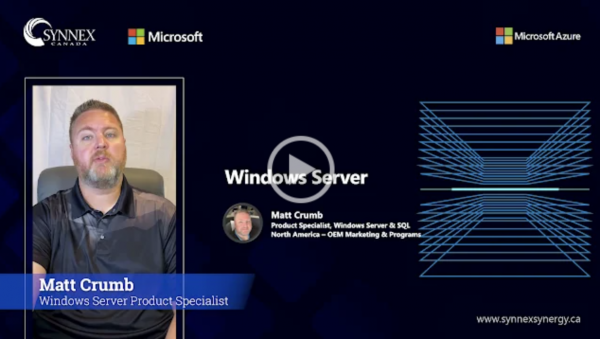Expect more with Windows Server 2022
Expect more with Windows Server 2022—for your customers and your business. With Windows Server 2022 on modern hardware, your customers can gain direct business benefits from cloud-ready hybrid capabilities, advanced multilayer security, simplified remote working, and flexible infrastructure. At the same time, you can grow your business by extending your reach and expanding your deal size.

Hybrid capabilities

Advanced

More secure

Modernized server
Sell Client Access Licenses with Windows Server licenses
Client Access Licenses (CALs) are different from software licenses, and both are required for customers who have purchased Windows Server 2022. The CALs give users and devices the legal right to access Windows Server.
User CALs: Single user with unlimited devices
Device CALs: Single device with unlimited users
Additive CALs: Required for advanced server functionality
Frequently asked questions
Windows Server 2022 is built on the strong foundation of Windows Server 2019 and brings innovation in four key areas: hybrid capabilities with Microsoft Azure, advanced multilayer security, more secure remote working, and modernized server infrastructure. Taking advantage of modern hardware features, Windows Server 2022 operates as a flexible cloud-ready platform, so you can have a hybrid infrastructure that helps enable additional layers of security and uses some capabilities of Azure.
Learn more about what’s new in Windows Server 2022.
Windows Server 2022 can help you modernize your existing server infrastructure—including hardware and software—to make your business more efficient and responsive. With transformed infrastructure, you can expect to see benefits like optimized IT operations, more seamless storage migration, enhanced security controls, and streamlined management.
Windows Server 2022 with modern hardware enables multilayer security—enhanced features at nearly every level of your business to help detect, respond to, and protect against new and emerging threats. Capabilities like Secured-core server, virtualization-based security, shielded virtual machines, and privileged identities can help your business stay protected.
There are two main editions of Windows Server 2022: Standard and Datacenter. Further, Windows Server 2022 Datacenter: Azure Edition can help you use the benefits of cloud to keep your virtual machines up to date while minimizing downtime. Choose from these editions based on the size of your organization as well as your virtualization and datacenter requirements.
Learn more about what’s new in Windows Server 2022.
Core licenses are sold in packs of 2 or 16. Each processor needs to be licensed with a minimum of eight core licenses (four 2-packs). Each physical server, including single-processor servers, needs to be licensed with a minimum of 16 core licenses (eight 2-packs or one 16-pack). One core license must be assigned for each physical core on the server. Additional cores can then be licensed in increments of 2-packs or 16-packs.
Windows Server Standard and Datacenter Editions continue to require either Windows Server CALs for every user or device accessing a server (see the product terms for exceptions) or Windows Server External Connector licenses for servers accessed by external users. In addition to the base Windows Server CAL or External Connector license, some functionalities require the purchase of an Additive Access License. Examples of additional or advanced functionalities include Remote Desktop Services or Active Directory Rights Management Services.
The Azure Hybrid Benefit lets you bring your on-premises Windows Server license with Software Assurance to Microsoft Azure. Rather than paying the full price for a new Windows Server virtual machine, you will only pay the base compute rate.
Each set of 16 Windows Server core licenses with Software Assurance entitles customers to use Windows Server on Microsoft Azure on up to 16 virtual cores allocated across two or fewer Azure virtual machines. Each additional set of eight entitles use on up to eight virtual cores and one Base Instance. In other words, once a minimum initial allocation of 16 licenses with Software Assurance is made, customers can add virtual cores (up to eight) to an existing or new virtual machine with incremental sets of eight licenses. Each incremental set of eight licenses must be allocated to a single virtual machine.
With Azure Hybrid Benefit, customers can move or add incremental workloads into Azure and pay non-Windows (Linux) pricing. With Datacenter Edition licensing, customers get these lower cost instances in Azure while maintaining existing on-premises deployments. This is referred to as “dual use rights.” Standard Edition licensing provides lower cost instances in Azure but not dual use rights.
Use of Windows Server on Azure is subject to Azure Services in the product terms site. This means access to base Windows Server functionality on Azure does not require base Windows Server CALs, and customers can take advantage of the Azure hosting clause to host their own customer solutions.
Interested in learning about Windows Server 2022? Watch our training video to know more about windows server and licensing options delivered by Matt Crumb, Windows Server Product Specialist.

Windows Server 2019 Step by Step Guide
SYNNEX Canada is here to equip you with the information and resources you need to support your customers, close deals and grow your business. Download for more information on how you can sell Windows Server 2019 at SYNNEX Canada with confidence.
Windows Server 2019 – Your Bridge to the Cloud February 1st, 2021
Windows Server 2019 is the operating system that bridges on-premises environments with Azure, adding additional layers of security while helping you modernize your applications and infrastructure. Learn about the latest Windows Server features and capabilities.


